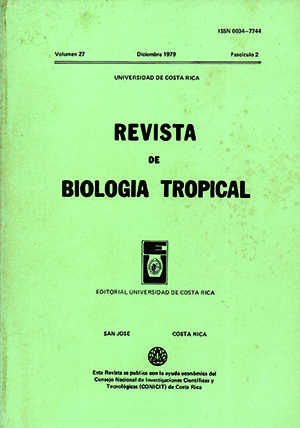Resumen
El cangrejo araña Microphrys bicornutus es un habitante común de las costas rocosas, arrecifes y praderas de pastos marinos del litoral del Caribe de Costa Rica. Este cangrejo presenta comportamiento decorador con materiales existentes en su medio. Se estudió el comportamiento con algas de diferentes colores, formas, tamaños y textura en diferentes colores de sustratos. Los resultados indican que este cangrejo tiene preferencia por algas de filamentos cortos, fmos y suaves, y no mostró ninguna tendencia a calzar el color de las algas con que se decoraba, con el color del sustrato.
Citas
Bürgi, A. 1968. Contribution a l'étude du comportement vis-a-vis d'objects étrangers chez les Majidae. Vie Mileu, 19: 215-304.
Cutress, C., D.M.Ross, & L Sutton. 1970. Association of Calliactis tricolor with its Pagurid, Callapid and Majid partners in the Caribbean. Canad. J. Zool., 48: 371-376.
Getty, T., & B.A. Hazlett. 1978. Decoration behavior in Microphrys bicornutus. Crustaceana, 34: 38-40.
Gordon, Isabella. 1960. Additional note on the Porcellanid sea anemone association. Crustaceana, 1: 166-167.
Hamilton, W.D. 1964. The genetical evolution of social behavior. I and II. J. Theoret. Biol., 7: 1-16; 17-52.
Minkiewicz, R. 1910. The instinct of self concealment and the choice of colors in crustacea. Ann. Rep. Bd. Smithson. Inst. Wash., 465-485.
Rathbun, Mary J. 1925. The spider crabs of America. Bull. U.S. Nat. Mus., 129: 1-613.
Ross, D.M. 1967. Behaviora! and ecological relationships between sea anernones and other invertebrates. Ann. Rev. Mar. Biol. Oceanog., 5: 291-316.
Ross, D.M.,& L Sutton 1961. The association between the hermit crab Dardanus arrosor and the sea anemone Calliactis parasitica. Proc. R. Soc., 155: 282-291.
Ross, D.M., & L. Sutton. 1968. Detachment of sea anemones by commensal hermit crabs and by mechanical and electrical stimuli. Nature, 217: 380-381.
Schöne, H. 1976. Tarn-und Schutzvcrhalten bei Krebsen. Publ. Wiss. Filmen, 9: 476-500.
Thomson, D.L. 1923. Note upon an association between spider crabs and sea anemones. J. Mar. Biol. Ass. U.K., 13, 243-244.
Trivers, R.L. 1971. The evolution of reciprocal altruismo Quart. Rev. Biol., 46: 35-57.
Wicksten, Mary K. 1975. Observations on decorating behavior following, molting in Loxorhfnchus crispatus. Crustaceana, 29: 315-316.
Wicksten, Mary K. 1977. Feeding in the decorator crab Loxorhynchus crispatus. Calif. Fish Game, 63: 122-124.
Wicksten, Mary K. 1978a. Attachment of decorating materials in Loxorhynchus crispatus. Trans. Amer. Micros. Soc., 97: 217-220.
Wicksten, Mary K. 1978b. The exterior decorator. Sea Frontiers, 24: 277-280.
##plugins.facebook.comentarios##

Esta obra está bajo una licencia internacional Creative Commons Atribución 4.0.
Derechos de autor 1979 Revista de Biología Tropical


